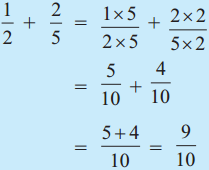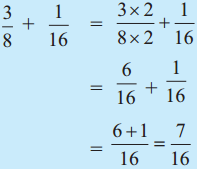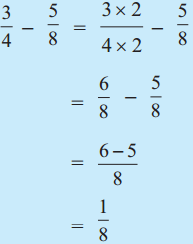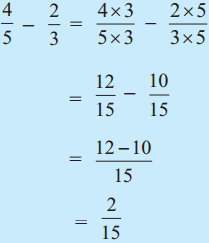Fractions Class 5 Problem Set 21 Question Answer Maharashtra Board
Balbharti Maharashtra Board Class 5 Maths Solutions Chapter 5 Fractions Problem Set 21 Textbook Exercise Important Questions and Answers.
Std 5 Maths Chapter 5 Fractions
Question 1.
Subtract the following.
\(\text { (1) } \frac{5}{7}-\frac{1}{7}\)
Answer:


\(\text { (2) } \frac{5}{8}-\frac{3}{8}\)
Answer:

\(\text { (3) } \frac{7}{9}-\frac{2}{9}\)
Answer:

\(\text { (4) } \frac{8}{11}-\frac{5}{11}\)
Answer:

\(\text { (5) } \frac{9}{13}-\frac{4}{13}\)
Answer:

\(\text { (6) } \frac{7}{10}-\frac{3}{10}\)
Answer:


\(\text { (7) } \frac{9}{12}-\frac{2}{12}\)
Answer:

\(\text { (8) } \frac{10}{15}-\frac{3}{15}\)
Answer:

Question 2.
\(\frac{7}{10}\) of a wall is to be painted. Ramu has painted 410 of it. How much more needs to be painted?
Solution:
To be painted – painted

Answer:
\(\frac{3}{10}\) more needs to be painted.
Addition and subtraction of unlike fractions
Example (1) Add : \(\frac{2}{3}+\frac{1}{6}\)


First let us show the fraction \(\frac{2}{3}\) by coloring two of the three equal parts on a strip.
You have learnt to add and to subtract fractions with common denominators. Here, we have to add the fraction \(\frac{1}{6}\) to the fraction \(\frac{2}{3}\).
 So let us divide each part on this strip into two equal parts. \(\frac{4}{6}\) is a fraction equivalent to \(\frac{2}{3}\). Now, as 16 is to be added to \(\frac{2}{3}\) i.e. to \(\frac{4}{6}\), we shall colour one more of the six parts on the strip. Now, the total coloured part is \(\frac{5}{6}\).
So let us divide each part on this strip into two equal parts. \(\frac{4}{6}\) is a fraction equivalent to \(\frac{2}{3}\). Now, as 16 is to be added to \(\frac{2}{3}\) i.e. to \(\frac{4}{6}\), we shall colour one more of the six parts on the strip. Now, the total coloured part is \(\frac{5}{6}\).

Therefore,

That is,

Example (2) Add : \(\frac{1}{2}+\frac{2}{5}\)
Here, the smallest common multiple of the two denominators is 10. So, we shall change the denominator of both fractions to 10.

Example (3) Add : \(\frac{3}{8}+\frac{1}{16}\)
Here, 16 is twice 8. So, we shall change the denominator of both fractions to 16.


Example (4) Subtract : \(\frac{3}{4}-\frac{5}{8}\)
Let us make 8 the common denominator of the given fractions.

Example (5) Subtract : \(\frac{4}{5}-\frac{2}{3}\)
The smallest common multiple of the denominators is 15. So, we shall change the denominator of both fractions to 15.

Addition and Subtraction Problem Set 13 Additional Important Questions and Answers
\(\text { (1) } \frac{9}{14}-\frac{3}{14}\)
Answer:


\(\text { (2) } \frac{5}{6}-\frac{3}{6}\)
Answer:

\(\text { (3) } \frac{9}{16}-\frac{5}{16}\)
Answer:

\(\text { (4) } \frac{7}{8}-\frac{3}{8}-\frac{1}{8}\)
Answer:

(5) \(\frac{7}{9}\) part of the work done by Neha and Supriya together. \(\frac{5}{9}\) part of this work was done by Neha. How much work done by Supriya?
Solution:
Total work done – work done by Neha = work done by Supriya

Answer:
\(\frac{2}{9}\) work done by Supriya

(6) Mr. Sharma is \(\frac{14}{9}\) m tall. Mrs. Sharma is \(\frac{4}{9}\) shorter than him. What is Mrs. Sharma’s height?
Solution:
Mrs. Sharma’s height

Answer:
Mrs. Sharma’s height = \(\frac{10}{9}\)